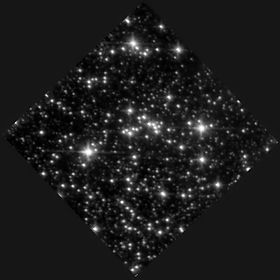LBV 1806-20
| 觀測資料 曆元 J2000 | |
|---|---|
| 星座 | 人馬座 |
| 星官 | |
| 赤經 | 18h 08m 40.31s[1] |
| 赤緯 | −20° 24′ 41.1″[1] |
| 視星等(V) | |
| 特性 | |
| 演化阶段 | LBV的候選者[2] |
| 光谱分类 | O9 - B2[2] |
| 视星等 (V) | ~35[3] |
| 视星等 (J) | 13.93[3] |
| 视星等 (H) | 10.75[3] |
| 视星等 (K) | 8.89[3] |
| 天体测定 | |
| 距离 | 8.7k[4] pc |
| 詳細資料 | |
| 質量 | 36[4] M☉ |
| 半徑 | 46-145[a] R☉ |
| 亮度 | ~2,000,000[2][5][6] L☉ |
| 溫度 | 18,000–32,000[3] K |
| 年齡 | 3.0 – 4.5[1] Myr |
| 其他命名 | |
2MASS J18084031-2024411
| |
| 參考資料庫 | |
| SIMBAD | 资料 |
LBV 1806-20是高光度藍變星的候選者,並且可能是一顆聯星。它與太陽的距離28,000光年(8,700秒差距),靠近銀河中心。估計它的質量為36太陽質量,亮度大約是太陽的200萬倍。它雖然有很高的亮度,但因為只有十億分之一的可見光到達我們這兒,因此在太陽系以可見光看不見這顆恆星。
當首度發現LBV 1806-20時,它被認為是最亮和已知質量最大的恆星,並且挑戰我們對大質量恆星形成的認知。最近的估計認為它離地球稍微近了點;當與聯星結合時,就可能在銀河系中及量恆星的預期參數範圍內。估計它的亮度是太陽的200萬倍,使它成為銀河系中最明亮的恆星之一。
位置
[编辑]LBV 1806-20位於電波星雲G10.0-03的核心,據信它是由恆星風提供動力[7],是疏散星團1806-20星團的成員。這個星團是銀河系最大的電離氫區W31的一部分。1806-20星團由一些極不尋常的恆星組成,包括4顆沃夫–瑞葉星、一些OB星、和γ射線反覆爆發源SGR 1806-20(磁星)[4]。
光譜
[编辑]LBV 1806-20的光譜類型不確定,可能是可變的。根據氦I的紅外線譜線的等效寬度,它已被限制在O9和B2之間。光譜顯示出強烈的氫的帕申(Paschen)和布拉開(Brackett)系列,但是也有氦、鐵II、鎂II、和鈉I的發射線。這些譜線都很寬,輪廓不均勻,有些顯現天鵝座P的配置[3]。高解析光譜顯示有修譜線是雙重的[2]。
性質
[编辑]雖然這顆恆星在2微米的[[紅外線波長下是顆8等星,但根據計算在可見光的波長下只是顆以現在的設備尚無法檢測到的35等星。估計在銀河中心方向上的塵埃吸收,使它在可見光的星等下降了29星等[2],因此大多數的觀測都是使用紅外線望遠鏡進行[4][1]。根據其亮度和光譜類型,懷疑它是一顆高光度藍變星。儘管有這樣的懷疑,但由於光度和光譜變化的特徵尚未觀察到,所以它依然只是個候選者[2][5]。
聯星
[编辑]為了解是其頻譜中氦I線的雙重性,以及在質量、亮度和年齡估計上的不一致,已經建議LBV 1806-20是聯星。為了解釋其頻譜中雙倍的 HeI 線及其品質、亮度和年齡估計值不一致,LBV 1806-20 已建議為二進位。發射線是單一的,當然就只有一顆恆星,但因為有密集的恆星風,可以預期高光度藍變星可以有雙重的譜線[2]。
註解
[编辑]參考資料
[编辑]- ^ 1.0 1.1 1.2 1.3 Figer, Donald F.; Najarro, Francisco; Geballe, T. R.; Blum, R. D.; Kudritzki, Rolf P. Massive Stars in the SGR 1806-20 Cluster. The Astrophysical Journal. 2005, 622 (1): L49. Bibcode:2005ApJ...622L..49F. arXiv:astro-ph/0501560
 . doi:10.1086/429159.
. doi:10.1086/429159.
- ^ 2.0 2.1 2.2 2.3 2.4 2.5 2.6 Figer, D. F.; Najarro, F.; Kudritzki, R. P. The Double-lined Spectrum of LBV 1806-20. The Astrophysical Journal. 2004, 610 (2): L109. Bibcode:2004ApJ...610L.109F. arXiv:astro-ph/0406316
 . doi:10.1086/423306.
. doi:10.1086/423306.
- ^ 3.0 3.1 3.2 3.3 3.4 3.5 Eikenberry, S. S.; Matthews, K.; Lavine, J. L.; Garske, M. A.; Hu, D.; Jackson, M. A.; Patel, S. G.; Barry, D. J.; Colonno, M. R.; Houck, J. R.; Wilson, J. C.; Corbel, S.; Smith, J. D. Infrared Observations of the Candidate LBV 1806‐20 and Nearby Cluster Stars. The Astrophysical Journal. 2004, 616 (1): 506–518. Bibcode:2004ApJ...616..506E. arXiv:astro-ph/0404435
 . doi:10.1086/422180.
. doi:10.1086/422180.
- ^ 4.0 4.1 4.2 4.3 Bibby, J. L.; Crowther, P. A.; Furness, J. P.; Clark, J. S. A downward revision to the distance of the 1806-20 cluster and associated magnetar from Gemini Near-Infrared Spectroscopy. Monthly Notices of the Royal Astronomical Society: Letters. 2008, 386 (1): L23. Bibcode:2008MNRAS.386L..23B. arXiv:0802.0815
 . doi:10.1111/j.1745-3933.2008.00453.x.
. doi:10.1111/j.1745-3933.2008.00453.x.
- ^ 5.0 5.1 Nazé, Y.; Rauw, G.; Hutsemékers, D. The first X-ray survey of Galactic luminous blue variables. Astronomy & Astrophysics. 2012, 538: A47. Bibcode:2012A&A...538A..47N. arXiv:1111.6375
 . doi:10.1051/0004-6361/201118040.
. doi:10.1051/0004-6361/201118040.
- ^ Abdalla, H.; Abramowski, A.; Aharonian, F.; Ait Benkhali, F.; Akhperjanian, A. G.; Angüner, E. O.; Arrieta, M.; Aubert, P.; Backes, M.; Balzer, A.; Barnard, M.; Becherini, Y.; Becker Tjus, J.; Berge, D.; Bernhard, S.; Bernlöhr, K.; Birsin, E.; Blackwell, R.; Böttcher, M.; Boisson, C.; Bolmont, J.; Bordas, P.; Bregeon, J.; Brun, F.; Brun, P.; Bryan, M.; Bulik, T.; Capasso, M.; Carr, J.; et al. Extended VHE γ-ray emission towards SGR1806−20, LBV 1806−20, and stellar cluster Cl* 1806−20. Astronomy & Astrophysics. 2018, 612: A11. arXiv:1606.05404
 . doi:10.1051/0004-6361/201628695.
. doi:10.1051/0004-6361/201628695.
- ^ Yeung, Paul K. H.; Kong, Albert K. H.; Tam, P. H. Thomas; Lin, Lupin C. C.; Hui, C. Y.; Hu, Chin-Ping; Cheng, K. S. Studying the SGR 1806-20/Cl* 1806-20 Region Using the Fermi Large Area Telescope. The Astrophysical Journal. 2016, 827 (1): 41. Bibcode:2016ApJ...827...41Y. arXiv:1606.01707
 . doi:10.3847/0004-637X/827/1/41.
. doi:10.3847/0004-637X/827/1/41.
| |||||||||||||||||||||||||||
Text is available under the CC BY-SA 4.0 license; additional terms may apply.
Images, videos and audio are available under their respective licenses.



